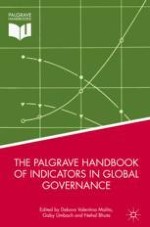2018 | OriginalPaper | Chapter
12. Measuring the Opposite of Corruption: The Evolution of Governance Indicators at Global Integrity
Authors : Hazel Feigenblatt, Johannes Tonn
Published in: The Palgrave Handbook of Indicators in Global Governance
Publisher: Springer International Publishing
Activate our intelligent search to find suitable subject content or patents.
Select sections of text to find matching patents with Artificial Intelligence. powered by
Select sections of text to find additional relevant content using AI-assisted search. powered by
